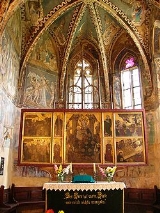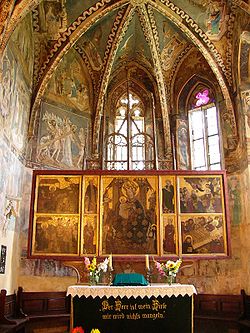
Laslea
Encyclopedia
Laslea is a commune located in Sibiu County
, Romania
. It is composed of five villages: Floreşti (Felsendorf; Földszin), Laslea, Mălâncrav (Malmkrog; Almakerék), Nou Săsesc (Neudorf; Apaújfalu) and Roandola (Rauthal; Rudály).
At the 2002 census, 65% of inhabitants were Romanians
, 23.9% Roma, 9.7% Germans
and 1.3% Hungarians. 76.2% were Romanian Orthodox, 7.2% Pentecostal
, 5.7% Evangelical Lutheran, 5.2% Seventh-day Adventist
, 2.6% Evangelical Church of Augustan Confession and 1.2% Baptist
.

Here are found the most significant Gothic
mural
s in Transylvania
aside from those at Ghelinţa
in Covasna County
.
The Saxon Romanesque
Lutheran
church has early 14th century Gothic murals in the apse
, 15th century ones in the nave
and a 15 century late Gothic altar
.
In later centuries the Apafi clan (Hungarian nobles in Transylvania) buried their dead in the church since they had overlordship in the village, but the sarcophagi were removed by the Communist regime
. The locality was not part of the autonomous Saxon territory, although until the 1970s it was populated by Germans.
bought and restored two 18th century Transylvanian Saxon houses in the villages of Mălâncrav and Viscri to help protect the unique way of life that has existed for hundreds of years and promote sustainable tourism
.
The buildings have been sensitively restored and converted into guesthouses for tourists. They remain in keeping with the surrounding architecture and feature a number of Transylvanian antiques but with modern facilities where possible.
The renovation of these buildings has helped provide a sustainable future for the people of rural Transylvania while also enabling residents to maintain their traditional way of life.
Sibiu County
Sibiu is a county of Romania, in the historical region Transylvania, with the capital city Sibiu.-Demographics:In 2002, it had a population of 421,724 and the population density was 78/km²....
, Romania
Romania
Romania is a country located at the crossroads of Central and Southeastern Europe, on the Lower Danube, within and outside the Carpathian arch, bordering on the Black Sea...
. It is composed of five villages: Floreşti (Felsendorf; Földszin), Laslea, Mălâncrav (Malmkrog; Almakerék), Nou Săsesc (Neudorf; Apaújfalu) and Roandola (Rauthal; Rudály).
At the 2002 census, 65% of inhabitants were Romanians
Romanians
The Romanians are an ethnic group native to Romania, who speak Romanian; they are the majority inhabitants of Romania....
, 23.9% Roma, 9.7% Germans
Germans
The Germans are a Germanic ethnic group native to Central Europe. The English term Germans has referred to the German-speaking population of the Holy Roman Empire since the Late Middle Ages....
and 1.3% Hungarians. 76.2% were Romanian Orthodox, 7.2% Pentecostal
Pentecostal Union of Romania
The Pentecostal Union of Romania is Romania's fourth-largest religious body and one of its eighteen officially recognised religious denominations. At the 2002 census, 330,486 Romanians declared themselves to be Pentecostals; ethnically, they were 85.2% Romanians, 10.6% Roma, 1.9% Ukrainians, 1.8%...
, 5.7% Evangelical Lutheran, 5.2% Seventh-day Adventist
Romanian Union Conference of Seventh-day Adventists
The Romanian Union Conference of Seventh-day Adventists is Romania's eighth-largest religious body. At the 2002 census, 97,041 Romanians declared themselves to be Seventh-Day Adventists; they have over 500 church buildings...
, 2.6% Evangelical Church of Augustan Confession and 1.2% Baptist
Baptist Union of Romania
The Baptist Union of Romania is an alliance of Baptist churches for cooperative ministry in Romania. Since independent churches have no legal standing in Romania, the Baptist Union also provides a mediatorial relationship between churches and government.The first modern-era Baptists in Romania...
.

Villages
Mălâncrav is a village in Laslea commune. A dirt road of 10 km leads to the village. It was originally populated by Transylvanian Saxons.Here are found the most significant Gothic
Gothic art
Gothic art was a Medieval art movement that developed in France out of Romanesque art in the mid-12th century, led by the concurrent development of Gothic architecture. It spread to all of Western Europe, but took over art more completely north of the Alps, never quite effacing more classical...
mural
Mural
A mural is any piece of artwork painted or applied directly on a wall, ceiling or other large permanent surface. A particularly distinguishing characteristic of mural painting is that the architectural elements of the given space are harmoniously incorporated into the picture.-History:Murals of...
s in Transylvania
Transylvania
Transylvania is a historical region in the central part of Romania. Bounded on the east and south by the Carpathian mountain range, historical Transylvania extended in the west to the Apuseni Mountains; however, the term sometimes encompasses not only Transylvania proper, but also the historical...
aside from those at Ghelinţa
Ghelinta
Ghelinţa is a commune in Covasna County, Romania. It is composed of two villages, Ghelinţa and Harale .It formed part of the Székely Land, ethno-cultural region of the historical Transylvania province.-Demographics:...
in Covasna County
Covasna County
Covasna is a county of Romania, in Transylvania, with the capital city at Sfântu Gheorghe.-Demographics:In 2002, it had a population of 222,449 and the population density was 60/km².*Hungarians – 73.79% *Romanians – 23.28%...
.
The Saxon Romanesque
Romanesque architecture
Romanesque architecture is an architectural style of Medieval Europe characterised by semi-circular arches. There is no consensus for the beginning date of the Romanesque architecture, with proposals ranging from the 6th to the 10th century. It developed in the 12th century into the Gothic style,...
Lutheran
Lutheranism
Lutheranism is a major branch of Western Christianity that identifies with the theology of Martin Luther, a German reformer. Luther's efforts to reform the theology and practice of the church launched the Protestant Reformation...
church has early 14th century Gothic murals in the apse
Apse
In architecture, the apse is a semicircular recess covered with a hemispherical vault or semi-dome...
, 15th century ones in the nave
Nave
In Romanesque and Gothic Christian abbey, cathedral basilica and church architecture, the nave is the central approach to the high altar, the main body of the church. "Nave" was probably suggested by the keel shape of its vaulting...
and a 15 century late Gothic altar
Altar
An altar is any structure upon which offerings such as sacrifices are made for religious purposes. Altars are usually found at shrines, and they can be located in temples, churches and other places of worship...
.
In later centuries the Apafi clan (Hungarian nobles in Transylvania) buried their dead in the church since they had overlordship in the village, but the sarcophagi were removed by the Communist regime
Communist Romania
Communist Romania was the period in Romanian history when that country was a Soviet-aligned communist state in the Eastern Bloc, with the dominant role of Romanian Communist Party enshrined in its successive constitutions...
. The locality was not part of the autonomous Saxon territory, although until the 1970s it was populated by Germans.
Prince of Wales and sustainable tourism
In 2006, The Prince of WalesCharles, Prince of Wales
Prince Charles, Prince of Wales is the heir apparent and eldest son of Queen Elizabeth II and Prince Philip, Duke of Edinburgh. Since 1958 his major title has been His Royal Highness The Prince of Wales. In Scotland he is additionally known as The Duke of Rothesay...
bought and restored two 18th century Transylvanian Saxon houses in the villages of Mălâncrav and Viscri to help protect the unique way of life that has existed for hundreds of years and promote sustainable tourism
Sustainable tourism
Sustainable tourism is tourism attempting to make a low impact on the environment and local culture, while helping to generate future employment for local people. The aim of sustainable tourism is to ensure that development brings a positive experience for local people, tourism companies and the...
.
The buildings have been sensitively restored and converted into guesthouses for tourists. They remain in keeping with the surrounding architecture and feature a number of Transylvanian antiques but with modern facilities where possible.
The renovation of these buildings has helped provide a sustainable future for the people of rural Transylvania while also enabling residents to maintain their traditional way of life.

